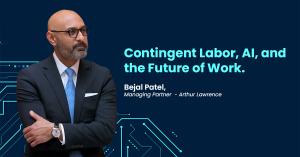Contingent Labor, AI, and the Future of Work
Bejal Patel, Arthur Lawrence's managing partner, talks about contingent labor, AI, and its impact on the recruitment industry on the Mission Matters Podcast.
HOUSTON, TX, UNITED STATES, October 13, 2025 /EINPresswire.com/ -- The future of work is being reshaped by two powerful forces: contingent labor and artificial intelligence. As organizations navigate an increasingly dynamic business landscape, contingent labor has emerged as a strategic solution offering flexibility, specialized expertise, and scalability without long-term commitments.
At the same time, AI is transforming how work is done, shifting from a perceived threat to a trusted collaborator. Rather than replacing people, AI enhances decision-making, automates routine tasks, and empowers human intelligence to focus on higher-value work.
Together, contingent talent and AI are redefining workforce models, creating a more adaptive, efficient, and innovation-driven economy. The organizations that embrace this collaboration between human expertise and intelligent technology will set the standard for productivity and competitiveness in the years ahead.
Bejal Patel shares insights on how contingent labor and AI are shaping a more agile, collaborative, and technology-driven future of work on the Mission Matters Podcast by Adam Torres.
Q: How do you define contingent labor, and why are more companies turning to it today?
Bejal Patel: Contingent labor refers to augmenting your existing workforce with temporary experts who bring specialized skills to address specific business needs. In simpler terms, it involves bringing in highly skilled professionals, essentially "mercenary experts," to fill critical gaps, deliver value within a defined scope, and then move on to the next challenge. This model allows organizations to operate on a pay-as-you-go basis, giving them agility without long-term commitments.
More companies today are turning to contingent labor because it provides flexibility, access to niche expertise, and the ability to scale teams up or down in response to dynamic market demands. In most cases, these contingent workers are managed directly by the client they serve rather than by their employer of record, ensuring that their contributions are closely aligned with the client’s immediate objectives.
Q: Can you share a practical example of how organizations use contingent labor in real business scenarios?
Bejal Patel: Consider a company that is implementing a new enterprise software solution, for example, an HR or financial management system. The internal team is typically occupied with maintaining existing operations and ensuring business continuity. In such cases, a contingent workforce can be brought in to manage the implementation of the new system while the core team continues to "keep the lights on." These contingent professionals handle the configuration, deployment, and initial training phases, ensuring a smooth transition. Once the system is fully implemented and the in-house team has been trained, the contingent experts step back, allowing the organization to operate independently.
In many cases, companies find strong alignment with these temporary professionals and may even extend offers for long-term roles due to their specialized knowledge and the value they deliver. The contingent model operates almost like a “switch on, switch off” approach; organizations can engage experts for six weeks, six months, or longer, depending on project needs. Once the specific objective is achieved, the professionals move on to their next assignment. This approach offers agility, cost efficiency, and immediate access to top-tier expertise without the long-term commitment associated with traditional hiring.
Q: How long do contingent labor-requiring projects typically last?
Bejal Patel: It really varies. Some projects may last as little as eight weeks, while others can extend up to two years. On average, our contingent workers stay with a client anywhere between 22 and 26 months. The key distinction lies in their focus. Traditional employees often have their attention divided across multiple responsibilities; they are expected to attend meetings, contribute to committees, provide feedback on various initiatives, and juggle a wide range of ongoing tasks.
In contrast, contingent workers are brought in to do one specific job, and that is where their full attention goes. Their time is not fragmented by organizational demands, which means the eight hours they contribute each day are spent entirely on the task they were hired to complete. This singular focus results in higher productivity, greater efficiency, and often a much higher quality of output within a shorter period of time.
Q: How do you see AI playing into all of this, both in contingent labor and the broader workforce?
Bejal Patel: I view AI as a collaborative partner rather than a competitive threat. It is not here to replace human talent but to work alongside it, enhancing how we think, create, and deliver value. Across multiple labor categories, including software engineering, financial analysis, and healthcare, AI is increasingly integrated into how work gets done. However, its real potential lies in complementing human intelligence, not substituting it. The most successful professionals will be those who learn to collaborate with AI, leveraging it as a tool to extend their capabilities rather than viewing it as a rival.
The reality is that AI is reshaping the workforce, including contingent labor, by creating new opportunities, new roles, and new efficiencies. Some traditional tasks may disappear, but they will be replaced by functions that require a higher degree of human-AI collaboration. Resistance to this shift only delays growth; embracing it, on the other hand, allows organizations and individuals to stay ahead of the curve. The future of work belongs to those who are open-minded, adaptable, and willing to harness AI as an ally in innovation.
Aseem Jibran
Arthur Lawrence
+1 213-493-6482
marketing@arthurlawrence.net
Legal Disclaimer:
EIN Presswire provides this news content "as is" without warranty of any kind. We do not accept any responsibility or liability for the accuracy, content, images, videos, licenses, completeness, legality, or reliability of the information contained in this article. If you have any complaints or copyright issues related to this article, kindly contact the author above.

